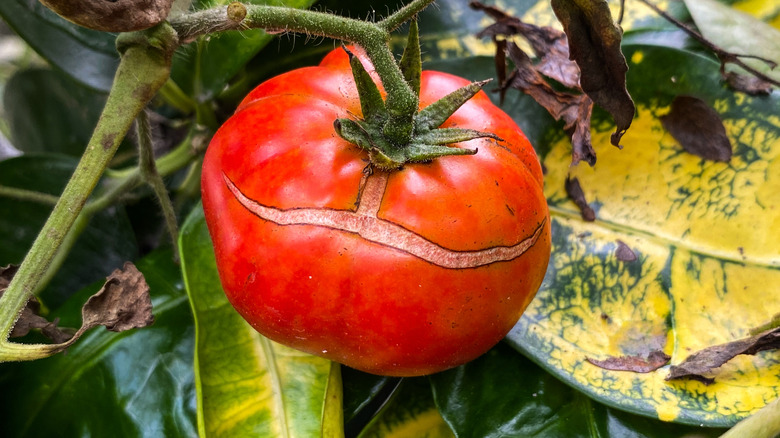If Your Tomato Plants Keep Cracking And Splitting, Do One Thing Immediately
Whatever variety of tomato plant you're growing, the fruits are susceptible to splitting and cracking for reasons that are often outside your control, such as temperature and moisture changes. This fragility means tomatoes may not be the best choice for beginner gardeners, but any gardener, especially those in rainy climates, can find their tomatoes cracking or splitting. But don't count those split tomatoes out too early. Harvesting immediately after noticing cracks is one of the handiest hacks to remember when growing tomatoes. Doing so allows them to stay edible, as long as they haven't cracked deeply enough for the fruits to rot or for pests to enter.
Once tomatoes crack, harvest them as soon as possible. If the fruit is split deeply enough for the seeds to be exposed, it can attract pests, bacteria, and mold. Plus, as the tomato gets riper, its skin becomes more fragile. But cracking can be an issue whether your tomatoes are ripe and have fully changed colors or not. In either case, harvesting quickly prevents further splitting and rotting, and picking the fruits while they still have some green color might even be beneficial.
Tomatoes that are ripe and have only small cracks are usually safe to eat as soon as they're picked (and you can cut the cracked part off as an extra precaution). Meanwhile, unripe split tomatoes should be harvested and moved indoors. This way, they'll continue to ripen and remain edible without the crack deepening and becoming more dangerous.
How to ripen split green tomatoes inside
If you've had to salvage your split unripe tomatoes and bring them inside, temperature control is important — the ideal temperature in the space is around 70 degrees Fahrenheit. Lay the tomatoes down on a sheet of newspaper and cover them with another sheet. Adding a few ripened tomatoes or a banana to the mix can speed up the process.
Check on the tomatoes every few days to see how their color has changed. Note that the ripening timeline might look different depending on the shade of green your tomatoes were when they were picked and the variety. If your tomatoes had to be harvested before they've had the chance to get close to ripening on the vine, they might not be as tasty and flavorful, but they can still be yummier than their store-bought counterparts, which are often lower in quality.
While most of the split tomatoes you find may be salvageable, some may show signs of disease, such as late blight, which manifests as deep, brown lesions. Think twice before adding such diseased plants to your compost. Some fungal diseases that affect plants have resting spores, which are resistant to heat, radiation, chemicals, and desiccation. That means that the fungi can lay dormant but still pose a danger to any plants it touches. Instead of taking the risk of composting, one option is to burn the infected plants and to avoid growing new tomatoes in the same location of the affected plant for at least two years.

